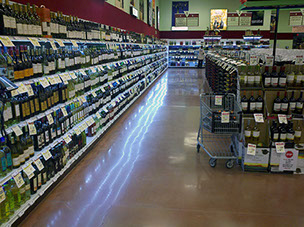Decorative Concrete Floors
 Adding color to concrete floors is an easy and relatively inexpensive way to enhance an otherwise gray floor. There are, generally speaking, five methods of adding decorative color to concrete floors:
Adding color to concrete floors is an easy and relatively inexpensive way to enhance an otherwise gray floor. There are, generally speaking, five methods of adding decorative color to concrete floors:
The MJA Company focuses on existing concrete and is fully trained and experienced with stains and dyes.
- Water-based stains: For new or existing floors
- Acid stains: For new or existing floors
- Concrete Dyes: For new or existing floors
For new concrete placement, there are two options available: Integral color and Dry-Shake color.
Although The MJA Company does not install new concrete, we can provide you with references to companies that we trust for placement and integral and shake-on coloring of concrete floors.
The difference between concrete stains and dyes
Concrete Stains:
Concrete stains react chemically with concrete to affect a permanent change in color. Stains may contain hydrochloric acid, metallic compounds and water. These chemicals react with the calcium chloride in the concrete and actually change the color of the concrete. Results with concrete stains vary depending on the properties of the concrete, even across different areas of the same floor.
Since concrete stains depend on chemical reactions for color, the results may be unpredictable. For instance, a blue stain may react with the concrete and actually deliver a green or rust color.
- Concrete stains are UV resistant and recommended over most dyes in areas that are subject to direct or indirect sunlight.
It is important to test several inconspicuous samples and allow them to set for at least 24 hours before making a final selection of concrete stains.
Concrete Dyes:
Concrete dyes are pigments carried into the concrete by water or solvents. Since dyes do not react with the concrete’s chemistry, they provide more uniform, predictable results.
Water based dyes create translucent, marbled, variable effects.
Solvent based dyes create a more predictable, consistent appearance with deeper, opaque colors.
- Concrete dyes are generally not UV resistant and not recommended in areas that are subject to direct or indirect sunlight.
Although concrete dyes are more predictable than stains, you should always test several options before making a final selection of concrete dyes.
